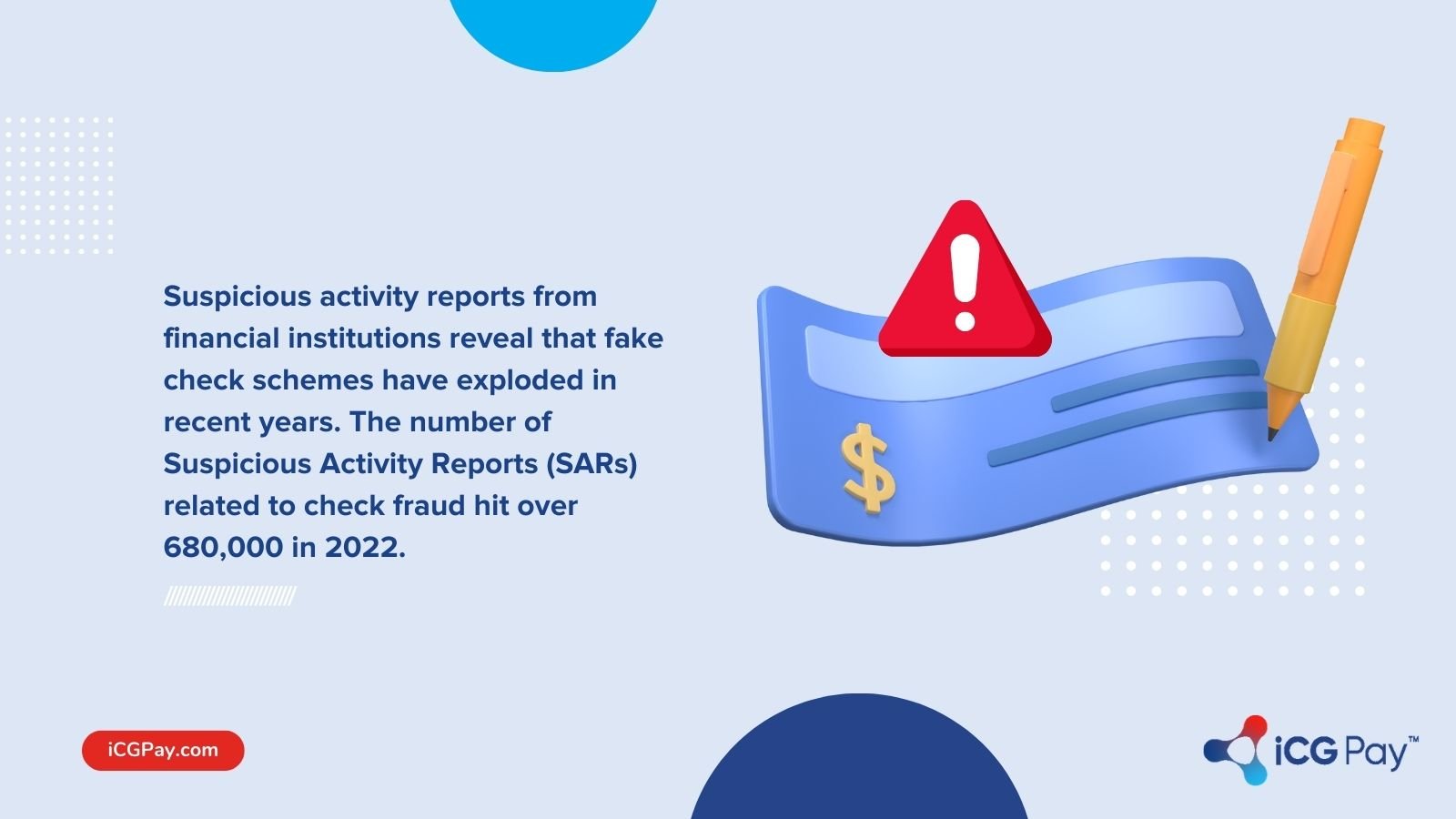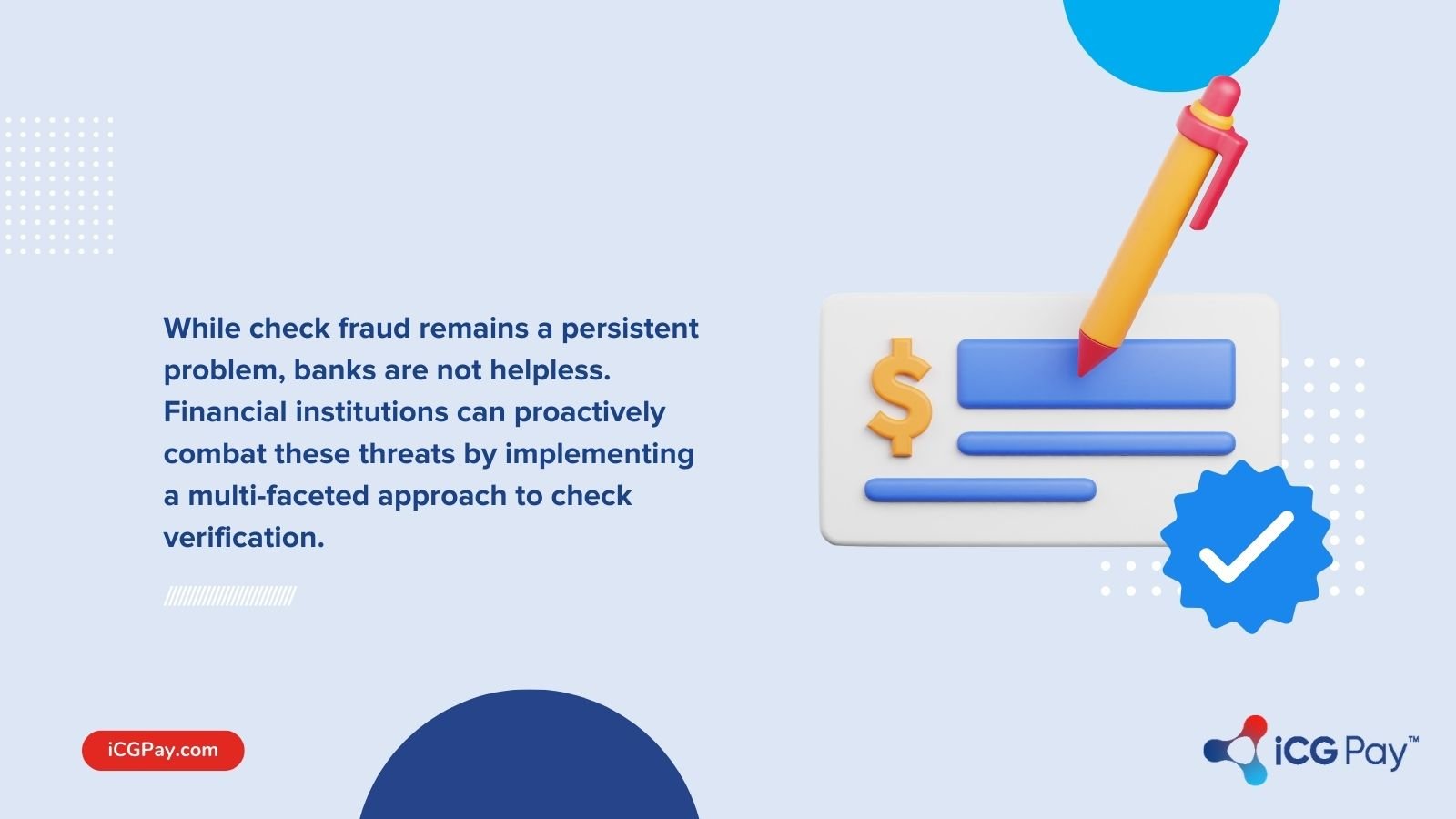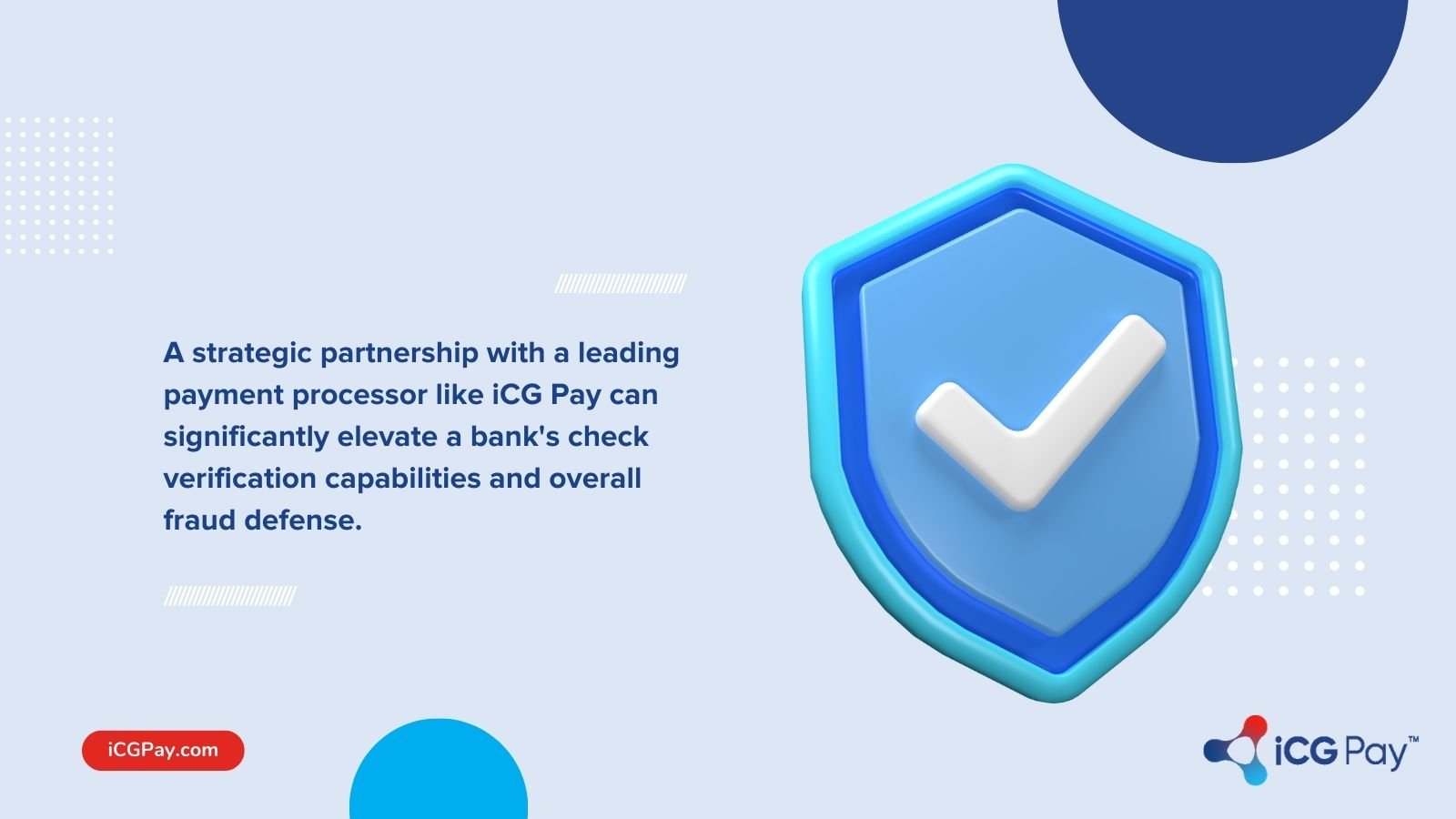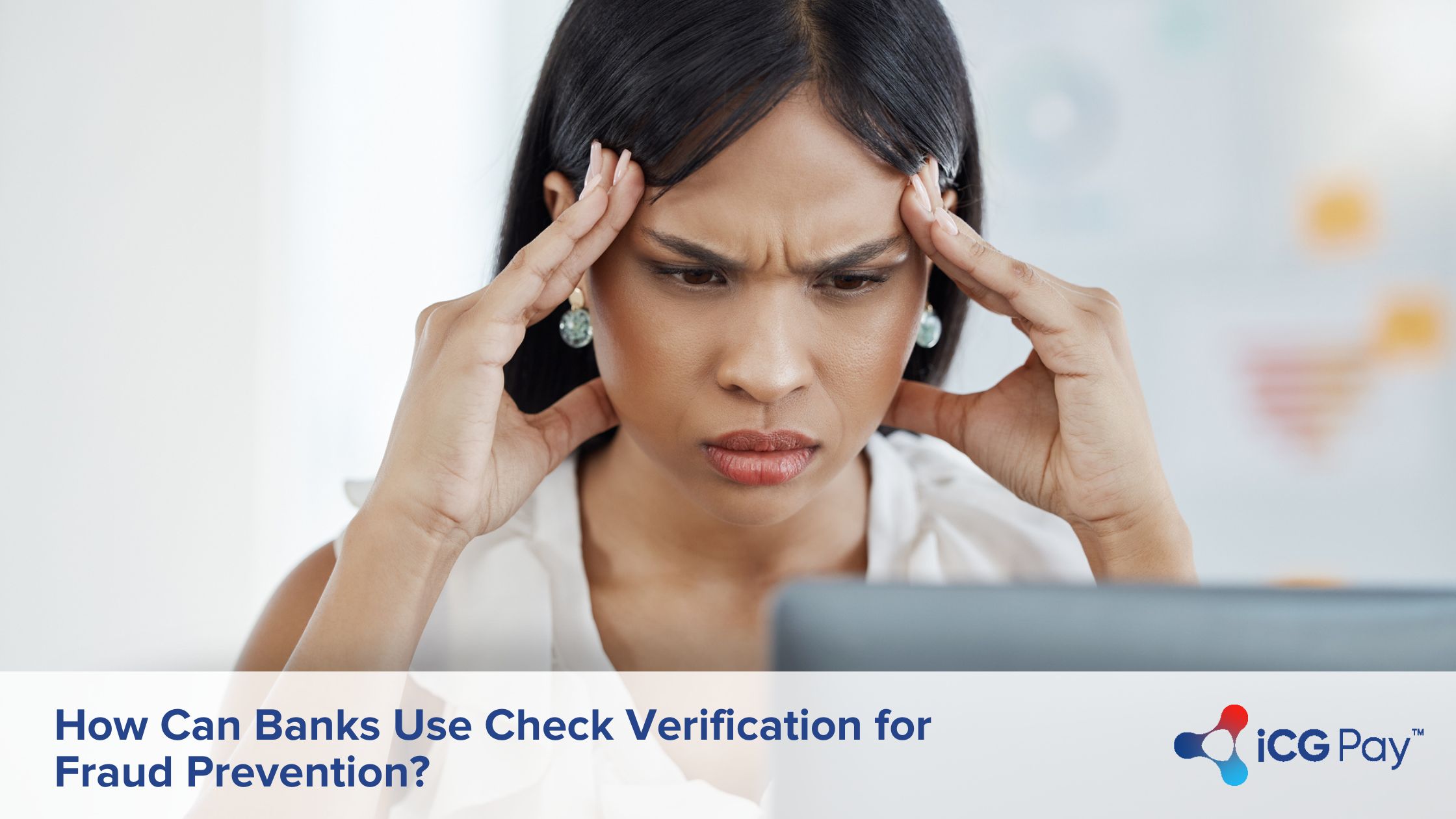Checks remain a relevant payment method. The 2022 Federal Reserve Payments Study found the value of check payments increased by 0.6% per year from 2018 to 2021. This translated to an increase in the average value of check payments from $1,908 in 2018 to $2,430 in 2021.
However, check fraud remains a costly problem. Losses reach billions of dollars annually, and banks bear the brunt of these losses from fraudulent checks clearing their books.
Sophisticated criminals also continually find new ways to exploit the paper check system. As such, financial institutions must take proactive measures to verify checks and prevent fraud.
So, how can banks safeguard themselves and their clients? Through a combination of traditional methods, cutting-edge technologies, and a culture of vigilance.
Let’s delve into how banks can combat check fraud. We’ll explore best practices, iCG Pay solutions, and the importance of a multi-layered approach.
What Types of Check Fraud Are Banks up Against?
Before we get into the solutions, let’s discuss the various types of fraud. Each scheme presents distinct challenges, demanding a targeted approach to verification.
Awareness of these fraud types helps banks understand the challenges check verification processes must address. Banks need solutions to detect and halt all fraud attempts, from counterfeit checks to forged signatures and altered amounts.
1. Counterfeit Checks
Counterfeits replicate all security features and details, making them extremely hard to spot without advanced verification processes.
Suspicious activity reports from financial institutions reveal that fake check schemes have exploded in recent years. The number of Suspicious Activity Reports (SARs) related to check fraud hit over 680,000 in 2022.
This figure dwarfs the 96,786 cases reported in 2014. You can clearly observe the exponential trend.
As counterfeits become more convincing at bypassing human inspection, banks increasingly need technology like artificial intelligence, machine learning, and threat intelligence.

2. Stolen Checks
Another prevalent check scam is stolen checks. That means genuine checks obtained illegally, often through theft from mailboxes, businesses, or even directly from individuals.
Fraudsters take these legitimate checks and forge signatures and personal information. They then use them fraudulently without the account holder's authorization.
Unlike counterfeit checks, stolen checks are genuine, making them harder to detect initially. They possess all the correct bank information and security features.
3. Altered Checks
Here, scammers take legitimate checks and modify them to commit fraud. This involves changing the payee's name, check signature, amount, or other crucial details.
Fraudsters use chemicals to erase original information (chemical washing) or carefully overwrite existing details. Sometimes, they even cut and paste portions from other checks to alter the intended recipient.
4. Check Kiting
Check kiting schemes exploit the "float" time. This is the delay between when a check is deposited and when the funds are actually withdrawn from the issuing bank.
Fraudsters strategically write checks between multiple accounts they control, often at different banks. They artificially inflate balances by depositing checks drawn on accounts with insufficient funds and withdrawing money before the scheme collapses.
Here’s how check-kiting works:
- The fraudster sets up accounts at two or more banks.
- They deposit a check with insufficient funds into Account A.
- Before the check clears, they write a check from Account A to Account B and deposit it, creating a false appearance of available funds.
- They continue writing checks between the accounts, creating a cycle of false balances.
- The fraudster then withdraws money before any of the bad checks bounce.
Check-kiting schemes are elaborate and difficult to detect, especially if they involve multiple accounts and institutions.
5. Checks from Closed/NSF Accounts
This check fraud involves writing checks on accounts that either don't exist anymore (closed) or lack sufficient funds (NSF — Non-Sufficient Funds) to cover the check's value.
Fraudsters deliberately exploit closed accounts or write checks, knowing they will bounce. They aim to receive goods, services, or cash before the lack of funds is discovered.
Businesses and individuals risk losses if they have already provided goods, services, or cash in exchange for the bad check. They may also incur fees associated with returned checks.
How Can Banks Combat Check Fraud with Verification?
Frank McKenna, a fraud strategist at Point Predictive, predicted that check fraud was going to hit $24 billion or more.
While check fraud remains a persistent problem, banks are not helpless. Financial institutions can proactively combat these threats by implementing a multi-faceted approach to check verification.

Here are the best practices all banks should have in place for check verification:
1. Physical Inspection
This is the first and obvious line of defense when dealing with checks. You need to look at a check to spot inconsistencies or anything that looks out of place.
Key details like inconsistent watermarks, MICR line encoding errors, abnormal grammar/spelling in the text, a suspect check number, and shading variations can be warning signs of counterfeits.
- Hold the check up to a light and see if a pattern emerges. Replicating watermarks is difficult.
- Look closely, ideally with a magnifying glass, at the fine print or borders. Fraudsters struggle to mimic the details of genuine microprinting.
- Use special equipment with ultraviolet light or a check scanner. Does the check reveal any hidden markings or fluorescent features?
Provide your frontline staff with security tools like special lights, magnification, verification pens, and updated imagery examples to help them with physical inspection and identity verification.
2. Signature Verification
Criminals who are good at duplicating security features sometimes overlook the importance of accurately forging signatures, leaving signs of suspicious activity in the cursive strokes.
Any unexplained deviations in how a customer normally signs should prompt additional scrutiny.
- Does the general appearance of the signature match the one on file?
- Are individual letters formed the same way (loops, tails, dots, etc.)?
- Is the spacing between letters and consistency of the signature's angle similar to the authentic one?
You can also utilize signature verification software that can assist in analyzing and comparing signatures.
3. AI-Powered Fraud Detection
As criminals increase their sophistication, so too must the fraud detection efforts of banks.
Artificial intelligence (AI) and machine learning analyze vast historical check data and transaction information. They create a deep understanding of typical account behavior, check formats, and normal patterns.
The AI algorithms excel at detecting subtle deviations from the norm. These might be slight changes in handwriting, unusual payee names, discrepancies in the check amount compared to the account's history, or any combination of red flags.
Also, by intelligently analyzing data, AI minimizes false positives that can create unnecessary friction for legitimate transactions.
4. Real-Time Verification
Real-time verification enables banks to instantly check the details of a check against the issuing bank's database during the deposit or point-of-sale transaction.
At the point of interaction (teller, ATM, mobile deposit), the check's image and key data are captured. This information is then securely transmitted to a verification service connected to multiple financial institutions.
The service queries the issuing bank to verify the account status (open/closed), available balance, and recent transaction history. Within seconds, the bank receives a response indicating whether the check is likely legitimate or requires further scrutiny.
5. Positive Pay
Positive pay is one of the most effective checks and balances in banks’ fraud toolkits.
This is a service banks offer to businesses, allowing you to pre-authorize a list of checks you’ve issued. This creates a crucial reference point for identifying potentially fraudulent checks.
Checks later presented for payment get compared against this list. Any discrepancies or checks not on the list generate an exception report for bank review.
The bank then provides the business with a list of all presented checks, and the company identifies those they did NOT authorize.
How Can iCG Pay Help Enhance Check Verification?
A strategic partnership with a leading payment processor like iCG Pay can significantly elevate a bank's check verification capabilities and overall fraud defense.
At iCG Pay, we offer advanced solutions and expertise that seamlessly integrate with your existing systems. We provide banks with a multi-faceted approach to combat check fraud.
Our iCG-Verify solutions are specifically designed to address the diverse challenges of check fraud for banks:
- Real-Time Account Verification: iCG-Verify taps into a vast network of financial institutions. The system utilizes real-time account checks, proprietary negative databases, and access to broader check history networks. This immediate detection helps intercept fraudulent checks before they are processed.
- Negative Data Sharing: iCG-Verify benefits from a comprehensive database of known bad check writers and fraudulent activity. The system utilizes real-time account checks, proprietary negative databases, and access to broader check history networks.
- Advanced Check Screening: Machine learning algorithms analyze vast amounts of data, recognizing patterns and anomalies that indicate potential fraud risk. This helps identify subtle anomalies, inconsistencies, and potential signs of counterfeit or altered checks that manual inspection might miss.
- Comprehensive Status Checks: iCG-Verify goes beyond basic routing number validation. We check for issues like closed accounts, insufficient funds, recent stop payments, and high debt activity on accounts.
Our check verification service enables banks to take preventative action before incurring financial losses from fraud.

Use iCG Pay’s Check Verification Solution to Prevent Fraud
Check fraud remains an evolving and potentially crippling threat facing banks and financial institutions. As criminals continually find new ways to exploit the paper check system, the responsibility falls on banks to implement cutting-edge defenses.
Partnering with a payment processor like iCG Pay, which offers ACH check verification, shared intelligence, and fraud prevention expertise, provides a powerful advantage in this fight.
Protect your profits and reputation. Partner with iCG Pay for advanced check verification solutions that stop fraud before it impacts your bottom line.




